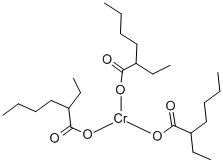CHROMIUM (III) 2-ETHYLHEXANOATE CAS#: 3444-17-5; ChemWhat Code: 36956
Identification
| Patent Information |
| No data available |
Physical Data
| Appearance | Dark green viscous liquid |
Spectra
| No data available |
Route of Synthesis (ROS)
| No data available |
Safety and Hazards
| Pictogram(s) |   |
| Signal | Danger |
| GHS Hazard Statements | H302 (25%): Harmful if swallowed [Warning Acute toxicity, oral] H312 (10%): Harmful in contact with skin [Warning Acute toxicity, dermal] H315 (45%): Causes skin irritation [Warning Skin corrosion/irritation] H317 (15%): May cause an allergic skin reaction [Warning Sensitization, Skin] H319 (50%): Causes serious eye irritation [Warning Serious eye damage/eye irritation] H360 (10%): May damage fertility or the unborn child [Danger Reproductive toxicity] H360D (20%): May damage the unborn child [Danger Reproductive toxicity] H361 (30%): Suspected of damaging fertility or the unborn child [Warning Reproductive toxicity] H412 (35%): Harmful to aquatic life with long lasting effects [Hazardous to the aquatic environment, long-term hazard] |
| Precautionary Statement Codes | P203, P261, P264, P264+P265, P270, P272, P273, P280, P301+P317, P302+P352, P305+P351+P338, P317, P318, P321, P330, P332+P317, P333+P317, P337+P317, P362+P364, P405, and P501 (The corresponding statement to each P-code can be found at the GHS Classification page.) |
| Source: European Chemicals Agency (ECHA) License Note: Use of the information, documents and data from the ECHA website is subject to the terms and conditions of this Legal Notice, and subject to other binding limitations provided for under applicable law, the information, documents and data made available on the ECHA website may be reproduced, distributed and/or used, totally or in part, for non-commercial purposes provided that ECHA is acknowledged as the source: “Source: European Chemicals Agency, http://echa.europa.eu/”. Such acknowledgement must be included in each copy of the material. ECHA permits and encourages organisations and individuals to create links to the ECHA website under the following cumulative conditions: Links can only be made to webpages that provide a link to the Legal Notice page. License URL: https://echa.europa.eu/web/guest/legal-notice Record Name: (1-Cyano-2-ethoxy-2-oxoethylidenaminooxy)dimethylamino-morpholino-carbenium hexafluorophosphate URL: https://echa.europa.eu/information-on-chemicals/cl-inventory-database/-/discli/details/213446 Description: The information provided here is aggregated from the “Notified classification and labelling” from ECHA’s C&L Inventory. Read more: https://echa.europa.eu/information-on-chemicals/cl-inventory-database |
Other Data
| Transportation | Under room temperature away from light; Sealed and keep ventilated. |
| HS Code | |
| Storage | Under room temperature away from light; Sealed and keep ventilated. |
| Shelf Life | 1 year |
| Market Price |
| Use Pattern |
| Chromic Octoate, also known as chromium octoate, is an organic chromium-based catalyst widely used in the petroleum, synthetic resin, and aerospace industries. Its chemical structure includes chromium, which provides excellent catalytic activity and stability, making it effective at promoting various chemical reactions even at low concentrations. In synthetic resin manufacturing, Chromic Octoate accelerates the curing process of unsaturated polyester and vinyl resins, enhancing the hardness and heat resistance of the final product. In the petroleum industry, it assists in the cracking process, increasing refining efficiency. Within aerospace, Chromic Octoate serves as a catalyst for thermosetting resins and composite materials, improving material strength and durability to withstand extreme conditions. Compared to other metal catalysts, Chromic Octoate is less toxic and relatively easy to handle and store, with low volatility, which minimizes environmental pollution risks. By carefully selecting the dosage and usage conditions, its catalytic performance can be optimized to meet high-quality production requirements. |
Buy Reagent | |
| No reagent supplier? | Send quick inquiry to ChemWhat |
| Want to be listed here as a reagent supplier? (Paid service) | Click here to contact ChemWhat |
Approved Manufacturers | |
| Want to be listed as an approved manufacturer (Requires approvement)? | Please download and fill out this form and send back to approved-manufacturers@chemwhat.com |
Contact Us for Other Help | |
| Contact us for other information or services | Click here to contact ChemWhat |

